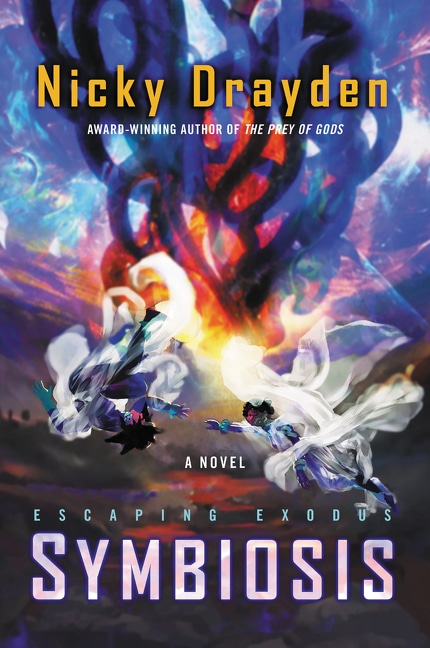Last year I was invited to review Escaping Exodus: Symbiosis – a sequel to Nicky Drayden’s Escaping Exodus. But there was a problem: I hadn’t read the first book! That was remedied quickly, and while a review of Escaping Exodus at the time would have been a little on the late side, I regret not writing it anyway.
Escaping Exodus is an amazing read, and was my first foray into afrofuturism. My return to the series and genre in Symbiosis was nothing short of spectacular.
What is Afrofuturism?
“The term ‘Afrofuturism’ was coined in 1990s by, cultural critic, Mark Dery in his edited collection Flame Wars: The Discourse of Cyberculture. Dery uses the term Afrofuturism to define “speculative fiction that treats African-American themes and addresses African-American concerns in the context of 20th century technoculture — and more generally, African-American signification that appropriates images of technology and a prosthetically enhanced future.”
Source
To put it a little more simply: it is where science fiction and African pride meet and blossom into something beautiful and, in many ways, challenging.
Marvel’s Black Panther, I’d argue, would qualify as an example of the genre. It isn’t just about black casts and futuristic technology; it’s about heavy cultural influences – the kind you can neither miss nor remove from what is presented without destroying what it is.
The same goes for both Escaping Exodus and Symbiosis. Are they science fiction works featuring black people? Yes. But they are so much more than that, and it is that more that establishes them as excellent examples of the genre and sets the series apart in both obvious and meaningful ways.
The Plot So Far
Disclaimer: I’m going to breeze through this a bit for the sake of brevity; particularly the information contained within Escaping Exodus. No major spoilers below.
Humanity has fled earth and taken up residence in gigantic space-faring aliens whose interiors are habitable. Humans are largely parasitic on these beasts, and while they work to maintain the creatures to a degree for their own sake, they routinely have to leave one for another as their host dies.
Events of the first book lead Seske, a member of the ruling class, to fight for major reforms with regards to the care of their vessels – what are revealed to be called Zenzee.
In the time between the first and second books, something closer to symbiosis is established with the Zenzee, but all is not well with or within them still. As old horrors are remediated, new horrors are unearthed. Last time it was their relationship with the Zenzee that required reform. This time, it is their very culture. And they’ll receive help from some very unlikely and unexpected sources.
Themes in Escaping Exodus
Author Nicky Drayden does some absolutely incredible work around the concepts of environmentalism, tradition, religion, gender, sexuality, class structure, family structure, love, eugenics, censorship and more. And maybe the most amazing thing about it is the interconnectedness of those themes. They are all rooted deeply within the culture and traditions of the people, but what has been is not always what should be.
And there’s more than a little relevant modern culture commentary at work here, in my opinion.
It is not often that I read a work of fiction and think, “Now this would make for an excellent book club book.” Book club selections, particularly works of fiction, should be capable of generating more than plot summaries and favorite moments when discussed. They should inspire good and even important discussions around their themes. Escaping Exodus has tremendous power within its pages to be that book series.
The world and characters and story Drayden imagines and invites you into are all excellent, but it is the themes that she tackles and writes of and around that give each of those things their clearest and strongest qualities.
And they way Drayden rolls each of these themes out through different types of conflict is really well done. It’s kind of like how once you address one pain in your body and it is alleviated you may become suddenly aware of another pain that was previously overshadowed but no less present. The problems of the world of Escaping Exodus cascade, and by the end of Symbiosis there’s the promise of a powerful remedy for at least some of them. But are they being sold snake oil?
Verdict
Escaping Exodus: Symbiosis is a stellar sequel. You’re absolutely going to want to read both – along with any future installments. Drayden is working straight magic in this series. It features some of my favorite world building in recent memory, and her character work with Seske and Doka in Symbiosis is top shelf.
This series has cast quite the spell on me. I honestly worry that I’d never have heard of it apart from the invitation to review Symbiosis, so I’m extremely grateful for the introduction and hope this review serves a similar purpose for you.
Both novels weigh in around an easily (and eagerly) consumed 330ish pages, so they’re not daunting undertakings. I could put neither one down. Escaping Exodus: Symbiosis releases on February 23rd – just sneaking in on the tail end of Black History Month. Befitting.
This sequel hasn’t even officially released yet, and I’m already desperate for the next installment of the series. I don’t know that there’s higher praise to bestow upon Drayden and the world, characters, and narrative of Escaping Exodus.
You can order a copy of Escaping Exodus here and preorder Escaping Exodus: Symbiosis here.
Disclosure: HarperCollins provided Nerds on Earth with an advanced reader copy of Escaping Exodus: Symbiosis in exchange for an honest review.


